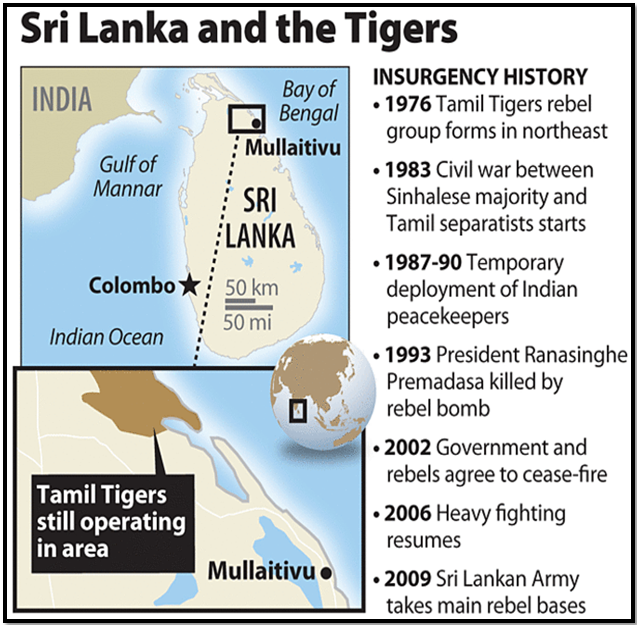“STAGNATION AFTER CONFLICT: SRI LANKA’S POST-WAR IMPASSE”
Syllabus:
GS-2 : Bilateral relations between India and Sri Lanka , Peace and security in the world, Neighbourhood first policy of India
Focus :
The article delves into Sri Lanka’s post-war impasse, highlighting the economic, political, and social challenges hindering the nation’s recovery. It explores the failure of reconstruction efforts, polarization between ethnic communities, and the need for visionary leadership to navigate towards reconciliation and sustainable development.
Introduction:
- Sri Lanka grapples with the aftermath of a prolonged civil war, with deep wounds still unhealed after more than a decade.
- Despite efforts, concerns regarding truth, accountability, and justice persist, alongside questions about the nation’s political future.
Derailed Reconstruction:
Incomplete Economic Revival:
- Despite visible signs of progress such as resumed train services and infrastructure development, rural communities continue to face economic hardships.
- The Easter terror bombings of 2019, followed by the COVID-19 pandemic and economic crisis, further derailed reconstruction efforts.
Widespread Economic Misery:
- Economic woes plague the nation, leading to significant outmigration and long queues at passport offices.
- War-torn populations, particularly the deprived and landless, struggle with limited economic opportunities and endemic hunger.
Failed International Assistance:
- Hopes of economic revival through investments from the Tamil diaspora remain unfulfilled.
- International donor projects focusing on infrastructure fail to stimulate the local economy effectively.
Source - TH
| Sri-Lankancivil war:
1. Background:
2. Root Causes:
3. Formation of Tamil Militancy:
4. Outbreak of Conflict:
5. International Involvement: India intervened in 1987 with the Indo-Sri Lanka Accord, aiming for devolution of power and disarmament of militants. Indian Peacekeeping Force (IPKF) faced resistance and withdrew in 1990, exacerbating the conflict. 6. Escalation and Peace Efforts:
|
Polarization and Minority Struggles:
Political Blame Game:
The Rajapaksa regime’s jingoistic nationalism exacerbates polarization, hindering post-war reconciliation.
Tamil nationalist politics mirrors Sinhala counterparts, perpetuating divisive rhetoric and victimhood narratives.
Lack of Political Reconciliation:
Failure to devolve power and share resources exacerbates tensions between communities.
Political elites prioritize self-interest over genuine reconciliation efforts, perpetuating a cycle of mistrust.
Minority Disenfranchisement:
Minority groups, including Northern Muslims and Hill Country Tamils, face marginalization and neglect.
Continued state control over minority lands and attacks on war memorials deepen minority grievances.
Way Forward for Sri Lanka:
Need for Visionary Leadership:
Sri Lanka requires leadership committed to social and economic justice, transcending ethnic divides.
Political elites must prioritize genuine reconciliation and inclusive development over partisan interests.
Revival of Grassroots Movements:
Grassroots movements can challenge authoritarianism and advocate for democratic values and equality.
Collaboration between diverse communities is essential to foster a collective vision for the nation’s future.
3. Rethinking Tamil Politics:
- Tamil politics must move beyond narrow nationalism towards a more inclusive and progressive agenda.
- By rejecting divisive narratives and embracing cooperation, Tamil communities can contribute to Sri Lanka’s democratic transformation.
Conclusion:
- Sri Lanka stands at a crossroads, facing the challenge of overcoming post-war stagnation and fostering genuine reconciliation.
- By prioritizing social justice, political inclusivity, and economic development, Sri Lanka can chart a path towards a more equitable and democratic future for all its citizens.
Source:The Hindu
Associated article :
https://universalinstitutions.com/india-sri-lanka-ties/
Mains Practice Question :
GS-2
“Analyse the socio-economic and political challenges facing post-war Sri Lanka and suggest measures to overcome the impasse for sustainable reconciliation and development.” (250 words)




